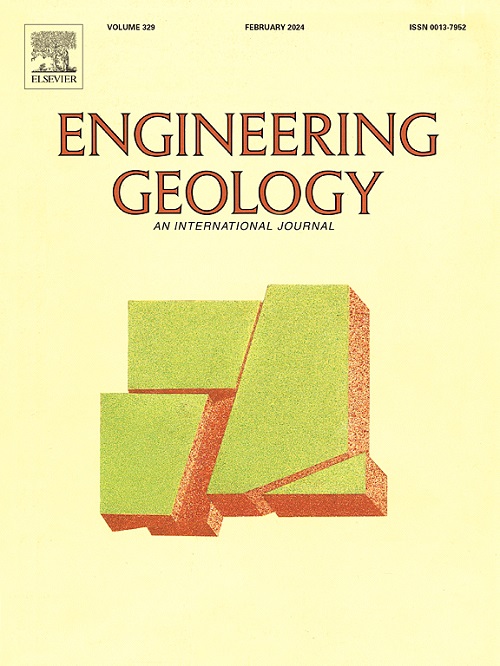基于物理的红土边坡降雨失稳失效时间测定
IF 6.9
1区 工程技术
Q1 ENGINEERING, GEOLOGICAL
引用次数: 0
摘要
传统的破坏时间是根据边坡表面随时间的位移来估计的,忽略了导致边坡失稳的关键岩土和环境因素。仪器和监测是昂贵的,劳动密集型的,而且往往不适合大量的山坡。本文重点研究了降雨入渗下印度西高止山脉红土边坡失效时间图的物理测定方法。有限元模型首先通过对位于印度马哈拉施特拉邦Ratnagiri地区的Kondavi土切割进行耦合流动变形分析来验证。土壤样本是从现场收集的,用于实验室的基本岩土工程特征。此外,采用滤纸法确定了土壤水分特征曲线(SWCC),采用van Genuchten模型获得了非饱和参数。在对孔davi切割失败的数值模型进行验证的基础上,研究了不同降雨强度下的安全系数(FOS)和破坏时间(TOF)以及土壤渗透性。建立了不同坡角(30°、45°、60°)、有效黏聚力(10 kPa、18 kPa、25 kPa)、有效摩擦角(22°、25°、28°)、地下水位(25 m、28 m、30 m、35 m)和坡高(15 m、25 m、35 m)下的TOF和FOS图。结果表明,当降雨强度小于土壤渗透性时,TOF取决于降雨强度和持续时间。降雨强度越大,破坏时间越短,反之亦然。相反,当降雨强度超过土壤渗透性时,TOF由降雨持续时间和土壤渗透性决定,因为无论降雨强度如何,降雨都以饱和渗透率入渗。摩擦是降雨诱发滑坡初始失稳的主要参数,而黏聚力是降雨诱发滑坡初始失稳的主要参数。最后,提出了可以作为确定印度红土边坡降雨引起的失稳TOF的初步指南的图表。通过比较另外两种失效红土岩屑的观测和预测TOF,进一步评估了图表的性能。这些发现的影响是深远的,因为拟议的TOF图表可以纳入早期预警系统,有助于改善减灾和备灾,及时做出决策,充分管理与滑坡有关的风险。本文章由计算机程序翻译,如有差异,请以英文原文为准。
Physics-based time-of-failure determination of rainfall-induced instability in lateritic soil slopes
Conventional time-of-failure estimated from slope surface displacement over time, ignores the crucial geotechnical and environmental causative factors that lead to slope instability. The instrumentation and monitoring are expensive, labour-intensive, and often not feasible for large number of hill slopes. This paper focuses on the physics-based determination of time-of-failure charts for laterite soil slopes prevalent in the Western Ghats of India, under rainfall infiltration. The finite element model was first validated by performing coupled flow deformation analysis of Kondavi soil cutting situated in the Ratnagiri district of Maharashtra, India. The soil samples were collected from the site for basic geotechnical characterisation in the laboratory. In addition, the soil water characteristics curve (SWCC) was determined using the filter paper method, and the unsaturated parameters were obtained using the van Genuchten model. Following the validation of numerical model with the failed Kondavi cutting, the factor of safety (FOS) and time-of-failure (TOF) were studied for varying rainfall intensity, and permeability of the soil. The FOS and TOF charts were then established for varying slope angles (30°, 45°, 60°), effective cohesion (10 kPa, 18 kPa, 25 kPa), effective friction angle (22°, 25°, 28°), water table depth (25 m, 28 m, 30 m, 35 m) and height of slope (15 m, 25 m, 35 m). Results indicate that if rainfall intensity is lower than soil permeability, TOF depends on both the intensity and duration of the rainfall. Higher rainfall intensity leads to a shorter time of failure, and vice versa. Conversely, when rainfall intensity exceeds soil permeability, TOF is determined by the duration of rainfall and the permeability of soil, as the rainfall infiltrates at the saturated permeability rate regardless of its intensity. It is also observed that friction is the dominant parameter for initial FOS, while cohesion is the dominant parameter for the TOF of a rainfall-induced landslide. Finally, charts are proposed that shall serve as a preliminary guide for the determination of the TOF for rainfall-induced instability in the lateritic soil slopes of India. The performance of the charts is further evaluated by comparing the observed and predicted TOF of two other failed laterite cuttings. The implications of these findings are profound, as the proposed TOF charts can be integrated into early warning systems, contributing towards improved disaster mitigation and preparedness with timely decision making for adequate management of landslide associated risks.
求助全文
通过发布文献求助,成功后即可免费获取论文全文。
去求助
来源期刊

Engineering Geology
地学-地球科学综合
CiteScore
13.70
自引率
12.20%
发文量
327
审稿时长
5.6 months
期刊介绍:
Engineering Geology, an international interdisciplinary journal, serves as a bridge between earth sciences and engineering, focusing on geological and geotechnical engineering. It welcomes studies with relevance to engineering, environmental concerns, and safety, catering to engineering geologists with backgrounds in geology or civil/mining engineering. Topics include applied geomorphology, structural geology, geophysics, geochemistry, environmental geology, hydrogeology, land use planning, natural hazards, remote sensing, soil and rock mechanics, and applied geotechnical engineering. The journal provides a platform for research at the intersection of geology and engineering disciplines.
 求助内容:
求助内容: 应助结果提醒方式:
应助结果提醒方式:


